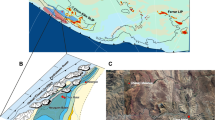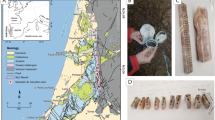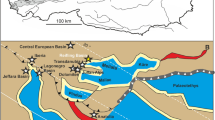Abstract
Understanding of the raised beach and other interglacial sequences in the southern part of the British Isles has been improved through use of the amino acid racemization technique. This method has permitted correlation of these isolated and fragmentary marine deposits1,2 which, except for the Portland site, are located around the shores of the Bristol Channel1. By applying this technique with the U-series method, we have obtained a geochronometric date from the ‘8-m’ raised beach of the Belle Hougue Cave, Jersey, Channel Islands. Our results suggest that the 8-m raised beach of the Channel should be correlated with isotope stage 5, and that raised beaches above this altitude in the area may pre-date this stage, and thus also the Ipswichian interglacial which forms part of it.
This is a preview of subscription content, access via your institution
Access options
Subscribe to this journal
Receive 51 print issues and online access
$199.00 per year
only $3.90 per issue
Buy this article
- Purchase on Springer Link
- Instant access to full article PDF
Prices may be subject to local taxes which are calculated during checkout
Similar content being viewed by others
References
Andrews, J. T., Bowen, D. Q. & Kidson, C. Nature 281, 556–558 (1979).
Miller, G. H., Hollin, J. T. & Andrews, J. T. Nature 281, 539–543 (1979).
Keen, D. H. Inst. geol. Sci. Rep. 78/26 (1979).
Mottershead, D. N. Geol. J. Spec. Iss. No. 7, 299–321 (1977).
Elhai, H. La Normandie occidental entre la Seine et la Golfe normand-breton, étudemorphologique, Bordeaux (1963).
Zeuner, F. E. A. Bull. Soc. Jersiaise XIV, 238–254 (1946).
Harmon, R. S., Thompson, P., Schwarcz, H. P. & Ford, D. C. Bull. natn speleol. Soc. 37, 21–33 (1975).
Shackleton, N. J. & Opdyke, N. D. Quat. Res. 3, 39–55 (1973).
Phillips, L. New Phytol. 73, 589–604 (1973).
Zeuner, F. E. The Pleistocene Period (Hutchinson, London, 1959).
Kidson, C. Geol. J. Spec. Iss. No. 7, 257–299 (1977).
Baden-Powell, D. F. W. Proc. malacol. Soc. 19, 67–76 (1931).
Bowen, D. Q. Proc. geol. Ass. 84, 249–272 (1973).
Stephens, N. in The Glaciations of Wales and Adjoining Regions (ed. Lewis, C.) (Longmans, London, 1970).
Butzer, K. W. in After the Australopithecines (eds Butzer, K. W. & Isaac, G. L1. (Mouton,The Hague, 1975).
Mesolella, K. J., Matthews, R. K., Broecker, W. S. & Thurber, D. L. J. Geol. 77, 250–275 (1969).
Bloom, A. L., Broecker, W. S., Chappell, J. S., Matthews, R. K. & Mesolella, K. J. Quat. Res. 4, 185–205 (1974).
Harmon, R. S., Schwarcz, H. P. & Ford, D. C. Quat. Res. 9, 205–218 (1978).
Neuman, A. C. & Moore, W. S. Quat. Res. 5, 215–227 (1975).
Author information
Authors and Affiliations
Rights and permissions
About this article
Cite this article
Keen, D., Harmon, R. & Andrews, J. U series and amino acid dates from Jersey. Nature 289, 162–164 (1981). https://doi.org/10.1038/289162a0
Received:
Accepted:
Issue Date:
DOI: https://doi.org/10.1038/289162a0
This article is cited by
-
Climate response over Asia/Arctic to change in orbital parameters for the last interglacial maximum
Geosciences Journal (2010)
-
Rapid dwarfing of red deer on Jersey in the Last Interglacial
Nature (1989)
-
Age of Pleistocene faunas from Bacon Hole, Wales
Nature (1986)
-
Amino acid analysis of Pleistocene marine molluscs from the Gower Peninsula
Nature (1983)
-
Amino acid evidence for Devensian ice, west Gower, South Wales
Nature (1982)
Comments
By submitting a comment you agree to abide by our Terms and Community Guidelines. If you find something abusive or that does not comply with our terms or guidelines please flag it as inappropriate.



